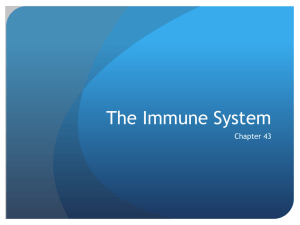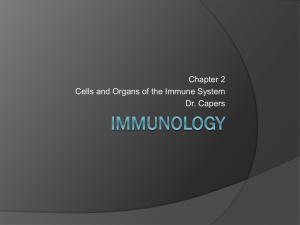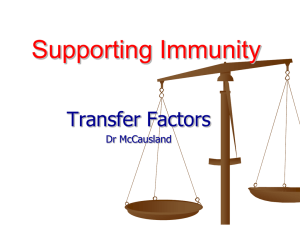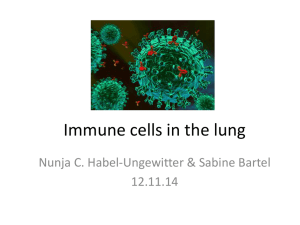Cells, organs and tissues of the immune system Innate immunity
advertisement
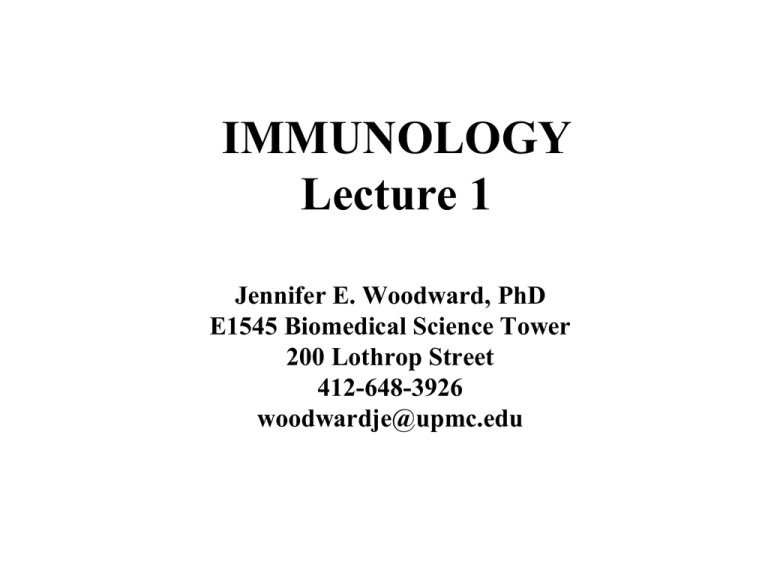
IMMUNOLOGY Lecture 1 Jennifer E. Woodward, PhD E1545 Biomedical Science Tower 200 Lothrop Street 412-648-3926 woodwardje@upmc.edu Outline Day 1 • What is immunology? • Cells, organs and tissues of the immune system • Innate immunity Outline Day 2 • Adaptive immunity – Antibodies – T cells • Antigen capture and presentation • Antigen receptors and development of the immune repertoire Outline Day 3 • Cell-mediated immune responses and effector mechanisms • Humoral immune responses and effector mechanisms Outline Day 4 • Autoimmunity • Transplantation • Tumor Immunology Definitions - 1 Immunology - is the study of all aspects of host defense against infection and of adverse consequences of immune responses. Immune response – the collective and coordinated response to the introduction of foreign substances (pathogens) in an individual Immune system – the molecules, cells, tissues and organs that collectively function to provide protection against pathogens Definitions - 2 Elements of the Immune System Molecules – Complement – Cytokines, chemokines – Antibodies Cells – Granulocytes (neutrophils, basophils/mast cells, eosinophils) Lymphocytes: T cells, B cells, and NK cells Tissues – Bone marrow – Thymus – Lymph nodes – Spleen – Blood Definitions - 3 Immunity – ability to resist infection Why has the immune system evolved? Protection / Defense against – invading pathogenic micro-organisms – cancer Functions of the Immune System 1. Immune Recognition – specificity a. Recognize subtle chemical differences that distinguish one foreign pathogen from another b. Discriminate between foreign molecule (antigen) and the body’s own cells and proteins Functions of the Immune System 2. Immune Response Immune recognition → recruitment of a variety of cells and molecules → mount an appropriate response (Effector Response unique – depends on particular organism ) → Eliminate or neutralize organism Memory Response Subsequent exposure to the same foreign organism Characterized by a more rapid and heightened immune response Invertebrates – simplest and most primitive immune system Vertebrates Innate Immunity – primitive immune system Adaptive Immunity – highly evolved immune system with specificity of a response Both innate and adaptive immunity work together for a high degree of protection Immunodeficiency Diseases – immune system fails because of a deficiency Autoimmunity – immune system becomes too aggressive and reacts against self/host Cells and Organs of the Immune System WBC = Leukocytes • Leukocytes are carried through the blood and lymph to populate lymphoid organs and to participate in the immune response • Lymphocytes are the only leukocytes that possess attributes of diversity, specificity, memory, and self/non-self recognition • All other leukocytes play an accessory role in adaptive immunity Hematopoiesis formation and development of red blood cells (erythrocytes) and white blood cells (leukocytes) initiated in humans early during gestation in the fetal yolk sac All blood cells arise from a single type of cell called a hematopoietic stem cell (HSC) homeostatic regulation of hematopoiesis is by programmed cell death (apoptosis) Hematopoietic Stem Cells Pluripotent (multipotent) – ability to differentiate into other types of cells – self-renewing – Differentiates along one of two pathways which is determined by growth factors and cytokines 1. Lymphoid progenitor cell 2. Myeloid progenitor cell Progenitor cells have lost the capacity for self-renewal and are committed to a particular lineage Common lymphoid progenitor cells give rise to B cells T cells NK cells Some dendritic cells Myeloid progenitor cells give rise to progenitor of red blood cells neutrophils eosinophils basophils monocytes mast cells dendritic cells megakaryocyte-platelet generating cell Cells of the Immune System • Lymphocytes – central cell of the immune system – constitutes 20-40% WBC – responsible for adaptive immune response – exhibits diversity, memory, specificity, self/nonself recognition – continuously circulating in blood – can migrate into tissues and lymphoid organs 3 populations of lymphocytes • B cells • T cells • NK cells Natural Killer Cells (NK Cells) • large, granular lymphocytes • do not express cell surface markers typical of T or B cells • 5-10% of lymphocytes in humans • cytotoxic activity against tumor cells, virus infected cells, etc. B Lymphocytes (B cells) • named for site of maturation – Bursa of Fabricius – bone marrow in humans, mice, etc. • mature B cells contain membrane bound immunoglobulin (Ig) on surface as receptor for antigen • can bind soluble antigen – no MHC required • Mature B cells also express B220, class II, CR1, CR2, B7-1, B7-2, and CD40 • can divide and differentiate when interact with antigen, APC and T cells to generate – plasma cells - lower level of membrane Ag; synthesize and secrete Ab; terminally differentiated cells (effectors) which die in 1-2 weeks – memory B cells T Lymphocytes (T Cells) • mature in thymus • T cell receptor (TCR) is the membrane receptor for antigen • do not recognize free/soluble antigen – must see antigen in context of MHC • contain distinctive membrane molecules – TCR, CD3 complex, CD4 or CD8, CD28, CD45 T Lymphocytes (T Cells) – cont. • T helper (TH) cells – provide help – effectors secrete cytokines that play a role in activation of cells of the immune response – TH1 secrete cytokines that support inflammation and activate T cells and macrophages – TH2 activate mainly B cells and immune responses dependent on Ab – CD4 on surface recognizes MHC class II • T cytotoxic (Tc) cells – cytotoxic – when recognize Ag on MHC, activate, proliferate and differentiate into cytotoxic T lymphocytes (CTL) which recognize and eliminate cells – CD8 on surface recognizes MHC class I • T suppressor (Ts) cells – subpopulation or new population of Tc or TH with a suppressor function – Suppress/downregulate humoral and cell-mediated immune responses B and T Cells • • • resting B and T cells are small, motile, and non-phagocytic Naïve or unprimed – no reaction with Ag – in Go phase of cell cycle – short life-span Enter cell cycle when interact with Ag – Go from Go to G1 then S1, G2 and M – Enlarge in size to lymphoblast (higher cytoplasm to nucleus ratio; more organelle complexity) – Proliferate and differentiate into • Effector cells – function to eliminate Ag; short lifespan –few days to a few weeks; distinguish by molecules on surface or • memory cells – persistent; responsible for lifelong immunity Mononuclear Phagocytes • Monocytes (circulate in blood) and macrophages (in tissues). • During hematopoiesis in bone marrow, granulocytemonocyte progenitor cells differentiate into promonocytes which enter into blood and mature into monocytes and move into tissues to differentiate into macrophages Difference between Monocytes and Macrophages • • • • • cell ↑ 5-10X intracellular organelles ↑ in number and complexity ↑ phagocytic ability produce high levels of hydrolytic enzymes secrete a variety of soluble factors Macrophages (MØ) have different functions in different tissues – Alveolar MØ – lung – Histocytes - connective tissue – Kupffer cells – liver – Mesangial cells – kidney – Osteoclasts – bone • MØ are activated by phagocytosis of Ag • Activated MØ are more effective at eliminating pathogens because of a greater phagocytic activity – ↑ ability to kill ingested microbes – ↑ secretion of inflammatory mediators – ↑ ability to activate T cells – ↑ production of cytotoxic proteins – ↑ levels of MHC class I, therefore, more effective APC Granulocytic Cells Based on morphology and cytoplasmic staining • phagocytic – Neutrophils = Polymorphonuclear leukocytes (PMNs) – Eosinophils • non-phagocytic – Basophils Neutrophil • • • • • PMN comprise 50-70% circulating WBC multi-lobed nucleus produced in the bone marrow released in peripheral blood – circulate 7-10 hrs with subsequent migration in tissues and die within a few days • large number released as first cells if an infection • lytic enzymes in 1º and 2 º granules when actively phagocytosing • kill microbes similar to macrophages but exhibit a larger production of oxygen and nitrogen intermediates Eosinophil • • • • • phagocytic bilobed nucleus that stains red with acidic dye constitutes 1-3% of circulating WBC play role in combating parasitic organisms content of granules are damaging to parasitic membranes Basophil • <1% of circulating cells • non-phagocytic • release pharmacologically active substances from granules • stain with basic dye • role in allergic responses Mast Cell • mast cell precursor forms in the bone marrow and released into blood as an undifferentiated cell but differentiates when leaves blood and enters tissues • found in skin, connective tissues, and various epithelial tissues of the respiratory, genitourinary and digestive tracts • cytoplasmic granules contain histamine and pharmacologically active substances important with basophils in allergies Dendritic Cell (DC) • contains long membrane extensions called dendrites • mature DCs present Ag to T cells • express high levels of both MHC class II and B7 family of costimulatory molecules • more potent APC than MØ and B cells Immune system is composed of many organs and tissues • 2 groups of organs – primary lymphoid organs – environment for the development and maturation of lymphocytes – secondary lymphoid organs – site where mature lymphocytes can interact with antigen • These organs are connected by blood vessels and the lymphatic system once mature lymphocytes leave primary lymphoid organs, they circulate in blood and lymphatic system lymphatic system – network of vessels that collect fluid from tissues that has escaped from capillaries of the circulatory system and ultimately returns to the blood Thymus • Site of T cell development and maturation • Flat, bilobed organ above the heart • function – generate and select a repertoire of T cells that protect the body from infection • lack of thymus – Nude mice – DiGeorge’s syndrome • reaches maximum size at puberty and then atrophies with age Bone Marrow • site of B cell origin and development in primates and rodents; in birds, B cells develop in the Bursa of Fabricius • B cells proliferate and differentiate within the bone marrow • stromal cells within the bone marrow interact directly with B cells and secrete cytokines for development Lymphatic System • As blood circulates under pressure, the fluid component (plasma) seeps through capillaries into tissues. A large portion of this fluid returns to the blood through capillary membranes. The remainder of the fluid is called lymph, which flows through spaces in connective tissue into a network of open lymphatic capillaries then into larger collecting vessels called lymphatic vessels, the largest being the thoracic duct which enters into the left subclavian vein near the heart. • The fluid flows by squeezing of body muscles rather than by heart pumping. Therefore, fluid goes in in one direction only. Lymphatic System – cont. Function – capture fluid lost from blood and return to blood to ensure a steady state of fluid within the circulatory system – picks up foreign antigen that has gained access to tissue and carried to various organized lymphoid tissues such as the lymph nodes which traps antigen as lymph passes from tissues to the lymphatic vessels, thus becoming progressively rich with lymphocytes – transporter of lymphocyte and antigen from connective tissue to organized lymphoid tissues where lymphocytes may interact with trapped antigen Secondary (2º) Lymphoid Organs • Located along vessels of lymphatic system • most highly organized 2º lymphoid organs which have not only lymphoid follicles but also distinct areas of T cell and B cell activity surrounded by a fibrous capsule – lymph nodes – spleen • less organized lymphoid tissue collectively called mucosal associated lymphoid tissue (MALT) found in various areas of the body – – – – Peyer’s Patches – small intestine Tonsils Appendix lymphoid follicle in lamina propria of smalls intestines and mucus membrane lining of upper airways, bronchi, and genital tract Lymph Nodes • site where immune responses are mounted against antigen in lymph • encapsulated bean-shaped structure containing a reticular network full of lymphocytes, macrophages and dendritic cells • located at junction of lymphatic vessels • encounter antigen that enter the tissue Spleen • Major role in mounting immune response to antigens in bloodstream • Large ovoid 2º lymphoid organ in abdominal cavity • Specializes in filtering blood and trapping blood borne antigens • Unlike lymph node, not supplied by lymphatics • Blood and antigen are carried by splenic artery • Surrounded by a capsule which extend a number of trabeculae to form compartmentalized structure Mucosal Associated Lymphoid Tissue (MALT) • organized lymphoid tissue which can be either loose, barely organized structural tissue, to well organized tissues – tonsils – Peyer’s Patches – appendix • defends the mucous membrane that lines the digestive, respiratory, and urogenital system which are major sites for pathogen entry • function as a large population of antibody producing plasma cells GI – Mucous Membranes • M cells – Specialized epithelial cells of mucous membranes that promote immune response by delivery of small samples of antigen from the urogenital tract, and lamina of the respiratory and digestive tracts to underlying mucosal associated lymphoid tissue – Flat cells that have deep cavities for capturing antigen, macrophages, B cells and T cells across basolateral membranes Many different cells, organs, and tissues of the immune system are dispersed throughout the body, yet the various components communicate and collaborate to produce an effective response to an infection Innate Immunity Innate Immunity • • • • ancient line of defense highly conserved between different species first line of defense against infection cellular and molecular components are present before onset of disease/infection and recognize classes of molecules peculiar to frequently encountered pathogens • mechanisms of action – non-specific, broad reactivity – occurs within hours of invasion • Phagocytic cells (neutrophils and macrophages) are involved • Broad Reactivity • Phagocytosis – main mechanism of action Innate Immunity 4 types of defensive barriers anatomic physiologic phagocytic inflammatory Anatomic and Physical Barriers Tend to prevent entry and is truly the 1st line of defense – skin – mucous membrane • • • • conjunctiva alimentary respiratory urogenital tract – non-specific mechanisms – saliva, tears, mucus secretions Physiologic Barriers • body temperature • pH • soluble and cell associated molecules – lysozyme – interferon – complement Many molecules in innate immunity have the ability to recognize (pattern recognition) a given class of molecules only found in microbes and not in multicellular organisms Ex: macrophages recognize LPS Organisms have developed/evolved ways to escape these defense mechanisms and invade body Ex: Influenza virus Gonorrhea Phagocytosis Ingestion of extracellular particular material/uptake by cell of material from the environment Steps of Phagocytosis 4 Cardinal Signs of Inflammation 1) 2) 3) 4) rubor = redness tumor = swelling calor = heat dolar = pain 5) loss of function Inflammatory Response = Inflammation Complex sequence of events induced by tissue damage caused by a wound or an invading pathogen 3 major events of an inflammatory response 1. 2. 3. vasodilation increased capillary permeability influx of phagocytes Mediated by chemical mediators which are released from invading microorganisms, damaged cells in response to tissue injury, several plasma enzyme systems or various WBC that are participating in the inflammatory response Influx of Phagocytes A Multi-step Process • Adherence of cells to endothelial wall of blood vessels (margination) • Emigration between capillary endothelial cells into tissues (diapedesis – extravasation) • Migration through tissue to site of invasion (chemotaxis) Phagocytes release lytic enzymes when accumulate at site and begin to phagocytize bacteria. The lytic enzyme can damage nearby healthy cells. Pus is the accumulation of dead cells, digested material and fluid. Chemical Mediators – released by Invading microorganisms – released from damaged cells in response to tissue injury – generated in several plasma enzyme systems – produced by participating WBC Once inflammatory response subsides and most of debris is cleared by phagocytic cells, tissue repair and regeneration of new tissue begins. Capillaries grow into fibrin clot, connective tissue fibroblasts replace fibrin and clot, and clot disappears. Scar tissue forms when fibroblasts and capillaries accumulate.



